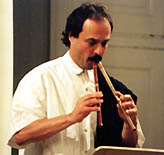The Greek aulos
The aulos with a double reed mouthpiece is an ancient Greek wind instrument. In 5th and 6th-century Athens there was not a single public ceremony or theatre performance, nor a sports or cultural event where it was not heard. Judging by scenes on many painted vases, especially those from around 500 BC, also by written records and a few surviving instruments, the sound of auloi must have been very peculiar, ranging from irritatingly shrill to deliciously sweet. This seems to imply that ?aulos' really denotes a group of differently-made instruments which were always played by professional and highly praised musicians.
Judging by scenes on many painted vases, especially those from around 500 BC, also by written records and a few surviving instruments, the sound of auloi must have been very peculiar, ranging from irritatingly shrill to deliciously sweet. This seems to imply that ?aulos' really denotes a group of differently-made instruments which were always played by professional and highly praised musicians.
Having been enthralled by this instrument for ten years now, we - the very sensitive and skilful instrument maker Paul J. Reichlin and myself as a player and, in various senses, an ?interpreter' - have familiarized ourselves with its different sounds. Our experience, whether at the bench, in a concert hall or at the desk studying ancient Greek songs and dances, has convinced us that the approach to this group of ancient instruments is proof that today's instruments are aulos's remote descendants. A mention could be made here of the Sartish triple launeddas which is played with the so-called raised tongue, or the double flute from Calabria, a region which was once part of Hellas. These instruments mediate to us also playing techniques which correspond very convincingly to needs posed by ancient Greek rhythms and melodies.
"Novel", unused or virtuoso sounds and techniques reach us in this way and are of interest not only to specialists. Suddenly sounds which seemed to have ceased so long ago and for ever, come vibrantly to life.



